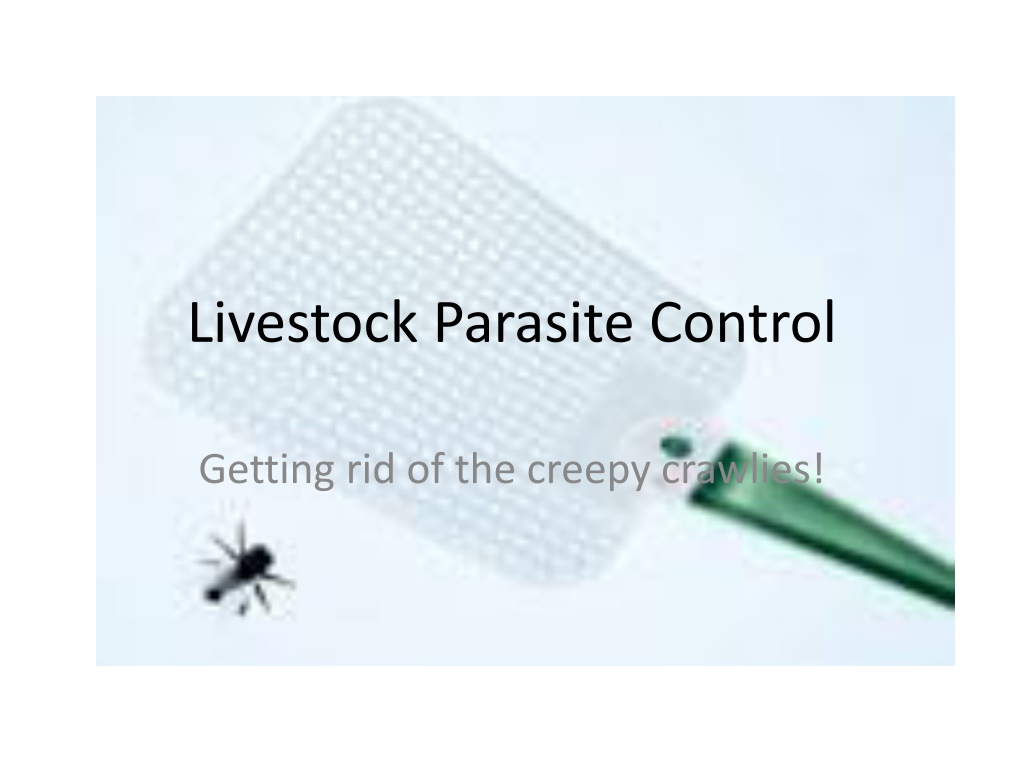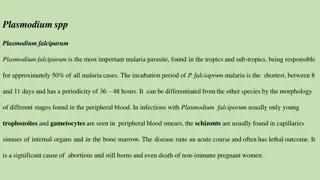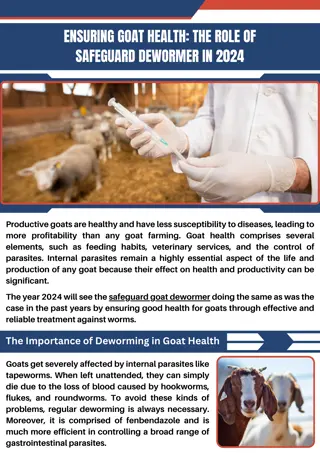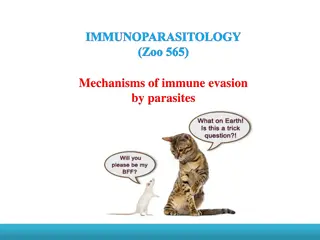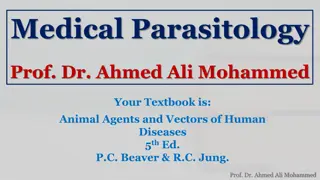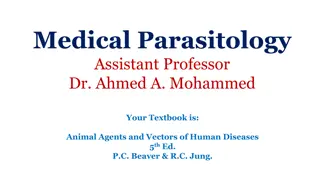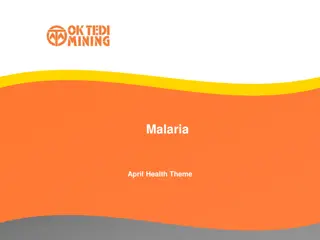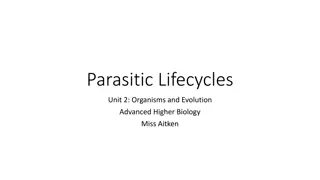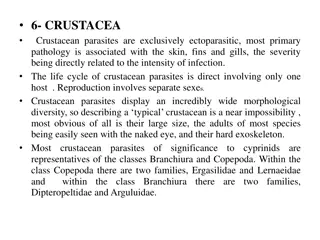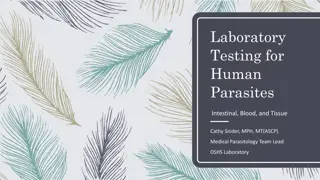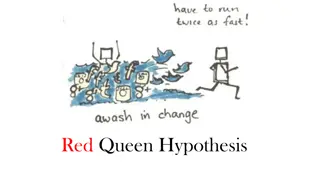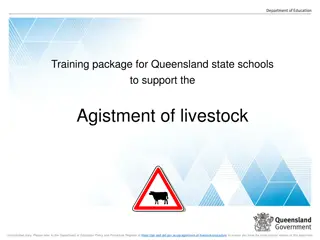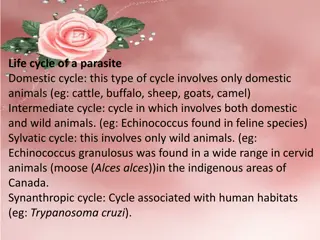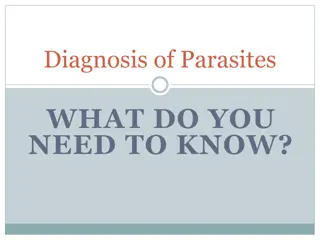Livestock Parasite Control: Effective Strategies for Managing Internal Parasites
Implementing strategic deworming practices using anthelmintics is essential to control internal parasites in livestock. Proper timing, targeted treatments, and awareness of coccidia can help prevent health issues and maintain animal well-being in cattle, sheep, and goats.
Download Presentation

Please find below an Image/Link to download the presentation.
The content on the website is provided AS IS for your information and personal use only. It may not be sold, licensed, or shared on other websites without obtaining consent from the author. Download presentation by click this link. If you encounter any issues during the download, it is possible that the publisher has removed the file from their server.
E N D
Presentation Transcript
Livestock Parasite Control Getting rid of the creepy crawlies!
Anthelmintics Anthelmintics are compounds used to kill gastro-intestinal parasites. Should be used wisely and sparingly Frequent use of anthelmintics will enable the worms to become resistant to the drugs It is also costly and may lead to a false sense of security Animals should be dewormed strategically Most important time to deworm is prior to (or at the time of) parturition When a female lactates, her immunity to parasites is compromised She is also the primary source of infection to her newborn Deworming animals prior to turning them out to spring pasture is also a good strategy because it helps to reduce the contamination of the pasture, as the worms resume their life cycle with the onset of good weather
Anthelmintics Some veterinarians have advocated multiple anthelmintic treatments in the spring to control the "summer" explosion of worms that occurs in a normal rainfall year Deworming the flock or herd in the fall after the first frost is also a good strategy, since this is the time the worms will go into a hypobiotic (dormant) state Animals should be dewormed prior to moving to a clean pasture Fecal egg counts may also be used to determine when the flock needs dewormed You have completed the fecal examination in previous classes Drug treatments should be targeted towards the animals that are the most susceptible to parasitism: lambs and kids, lactating ewes and does, and high-producing animals Animals not showing symptoms of parasitism (e.g. anemia) may be left untreated Animals which are more susceptible to parasites should be culled
Coccidia All animals have coccidia Coccidia are single-cell protozoa that damage the lining of the small intestines. Since the small intestine is where nutrient absorption takes place, coccidiosis can permanently stunt young animals Coccidia are species-specific, meaning the coccidia species that affect sheep and goats are different from those that affect poultry and rabbits Coccidia cause weight loss and ill health in lambs/kids and diarrhea, which may be streaked with blood or mucous Affected lambs/kids become weak and dehydrated and die Coccidia are more of a problem in sheep and goats that are in confinement or under intensive grazing systems (stomach worms are more of a problem with sheep and goats on pasture)
Coccidia Outbreaks of coccidiosis are caused by poor sanitation, overcrowding (or overstocking), and stress Coccidiosis can be controlled by good sanitation, clean water, not feeding on the ground, and not overstocking pens and pastures Disease outbreaks can be prevented by administering Corid (Amprolium) in the water supply or by including a coccidiostat in the feed or mineral Bovatec (lasalocid) and Deccox are both FDA-approved as coccidiostats for lambs Rumensin (monensin) and Deccox are FDA-approved to prevent coccidiosis in goats Outbreaks of coccidiosis can be treated with sulfa drugs and Corid Severely affected animals will require supportive therapy (e.g. fluids).
Tapeworms & Lungworms Internal parasites of lesser concern are tapeworms and lungworms Tapeworms, which are visible in the manure, can cause weight loss and death in extreme cases Tapeworms can be controlled by administering an anthelmintic from the benzimidazole family (e.g. Safeguard, Valbazan) Sheep and goats become infested with lungworms when they consume larvae from the pasture and the larvae travels to the respiratory system Symptoms of lungworms are not easy to recognize, and only in extreme cases do lungworms cause severe respiratory distress The same drugs which control stomach worms will also control lungworms [benzimidazole family (e.g. Safeguard, Valbazan)]
External Parasites Sheep and goats may also get external parasites The sheep tick is called a "ked" and it can substantially decrease pelt value Goats are more likely to get mange mites and lice Sheep and goats with "snotty" noses may have nose bots, a nasal passage parasite These various "biting" parasites can be controlled by administering an anthelmintic from the Macrolytic Lactone family or Avermectin family (e.g. Ivomec, Moxidectin).
Parasite Control Products Anti-parasitic drugs should always be administered to animals orally (drenching), even if a pour-on or injectable product can be used Single and multi-dose drench guns are available for administering oral medications to sheep and goats Restrain the animal by straddling it or standing beside it and placing your hand under its jaw Restrain large animals using a squeeze chute Syringe should be inserted into the corner of the animal's mouth and rested on its tongue Plunger should be slowly pushed so that the medicine goes over the tongue Once the animal has swallowed the syringe can be released Care should be taken not to underdose animals Weight should be obtained using a scale or tape measure to assure proper dosage Underdosing leads to drug resistance
Parasite Control Products Drug families should be rotated on an annual basis to slow the rate of drug resistance There are three families of drugs which have been used to treat sheep and goats for internal parasites Benzimidazoles (white dewormers) - Fenbendazole (SafeGuard/Panacur), Albendazole (Valbazen), and Oxybendazole (Synanthic) Nicotinics - Levamisole (Tramisol/Levasol), Pyrantel (Strongid), and Moratel (Rumatel) Macrolytic Lactones or Avermectins - Ivermectin (Ivomec), Doramectin (Dectomax), and Moxidectin (Cydectin/Quest) Only Fenbendazole and Rumatel are FDA-approved for use in goats.
Common Dosages Valbazen Safe Guard Ivomec Synantic Cydectin Levamisole Ivermectin (injectable) Dectomax (injectable) 3cc/100# 4.5cc/100# 3cc/26# 2.5cc/10# 1cc/11# Bolus by weight 1cc/110# 1cc/110#
Parasite Control Products Use of any animal health product which is inconsistent (species, route, or dosage) with its label constitutes "extra-label or off-label drug use and requires a veterinary prescription and valid veterinarian-patient-client relationship Exaggerated withdrawals should be used whenever administering a drug extra-label Note - many anthelmintics and other drugs are not approved for use in sheep and goats and require veterinary consultation
Drenching Guns for Livestock Drench guns are used with smaller livestock: goats and sheep mainly. The anthelminthic is drawn into the syringe, and the applicator is inserted into the animal mouth, on top of the tongue, towards the back of the mouth. After depressing the syringe, hold the animals mouth up to help prevent them from spitting the medication out. Always read the label directions and administer the proper dosage for the size and age of the animal. Be sure to read all warnings on the medication as to species, age, size, pregnancy, and withdrawal period.
Properly restrain the animals when drenching, preventing injury to the animal or person.
Balling guns are used to administer a bolus (large pills) Metal balling guns last longer. Insert bolus into opening and insert into the back of the animals mouth, depress the plunger. Hold the animals mouth up so they will swallow the bolus.
External Parasites External parasites can be controlled using a variety of methods. Dust bags can be hung for cattle to rub on. It will release a fly & tick dust. Insect traps can be used in smaller areas. Baits will attract and kill most flies.
